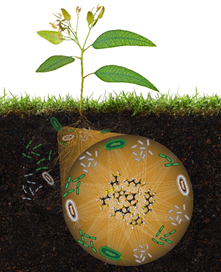 Technical advances in DNA sequencing and related technologies has led to an explosion in the sequenced universe. However, functional characterization of these remains a difficult challenge. The Metabolomics group at JGI strives to integrate metabolomics with genomic information to provide successful functional annotation of genomes and improved understanding of the role of small molecules in diverse biological systems relevant to DOE missions.
Technical advances in DNA sequencing and related technologies has led to an explosion in the sequenced universe. However, functional characterization of these remains a difficult challenge. The Metabolomics group at JGI strives to integrate metabolomics with genomic information to provide successful functional annotation of genomes and improved understanding of the role of small molecules in diverse biological systems relevant to DOE missions.
This capability can lead to important findings:
- Discovery of new secondary metabolites and pathways
- Role of primary and secondary metabolites in modulating biological interactions
- Linking environmental change with metabolism and genomics
- Linking metabolite production and gene expression
- Novel insights related to nutrient exchange and cross-feeding between plants, microbes, fungi and the environment
- Microbiome nutrient cycling in soils and the rhizosphere
To analyze metabolites in complex biological systems, the Metabolomics group at JGI applies advanced mass spectrometry-based methods in combination with advanced computational analysis. Major efforts have been made in developing workflows for extracting and profiling metabolites from a wide range of samples, including organisms (e.g. microbes, fungi, plant) and media in which they grow, as well as different types of environmental samples (e.g. soil, lake).
Using high resolution mass spectrometry coupled to liquid chromatographic separation, we are able to identify a wide range of metabolites based on thousands of metabolite standards. The following types of mass spectrometry analyses may be requested in a proposal:
- Polar metabolite analysis (e.g. amino acids, nucleic acids, sugars, small organic acids, metabolites in central metabolism, etc.)
- Non-polar metabolite analysis (e.g. secondary metabolites, polyketides, other more hydrophobic compounds, etc.)
For these analyses, JGI has run 1000+ metabolite standards (and growing) of primary and secondary metabolites including a broad range of amino acids, nucleic acids, lipids, flavonoids, alkaloids and more. These are used in our “targeted” approach, in which metabolites are definitively identified in samples based on MS properties such as retention time, fragmentation spectra and accurate mass. Our “untargeted” approach is required in the absence of standards and for discovery of novel compounds where we apply custom and open-source software and algorithms for identification.
Novel biological insights can be discovered with detected metabolites by providing an orthogonal source of information synergistic with transcriptomic and genomic datasets. Additional capabilities in various stages of development include stable isotope labeling as well as lipidomics. Please contact the Metabolomics group lead Trent Northen or Katherine Louie to discuss available metabolomics analyses complementary to your research.
JGI’s metabolomics capabilities can be accessed for projects that integrate with JGI’s sequencing and synthesis resources through Community Science Program (CSP) and Facilities Integrating Collaborations for User Science (FICUS) proposals. Project proposals are chosen based on scientific merit and relevance to the DOE mission, and judged through independent peer review.
-
Resources for JGI metabolomics technology
-
More about this program